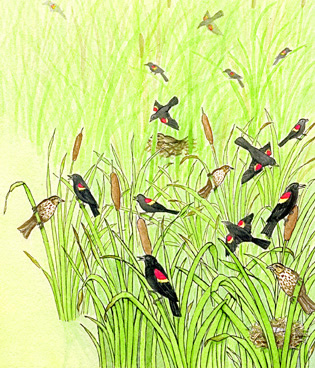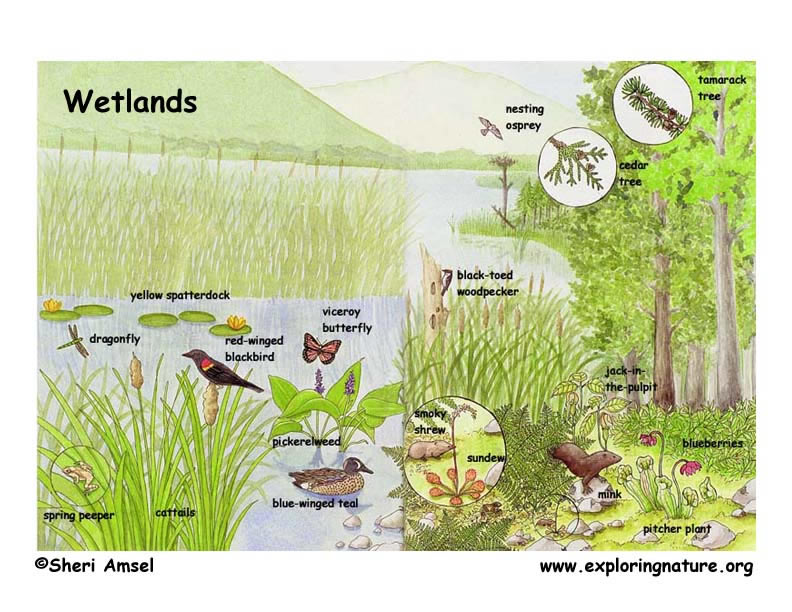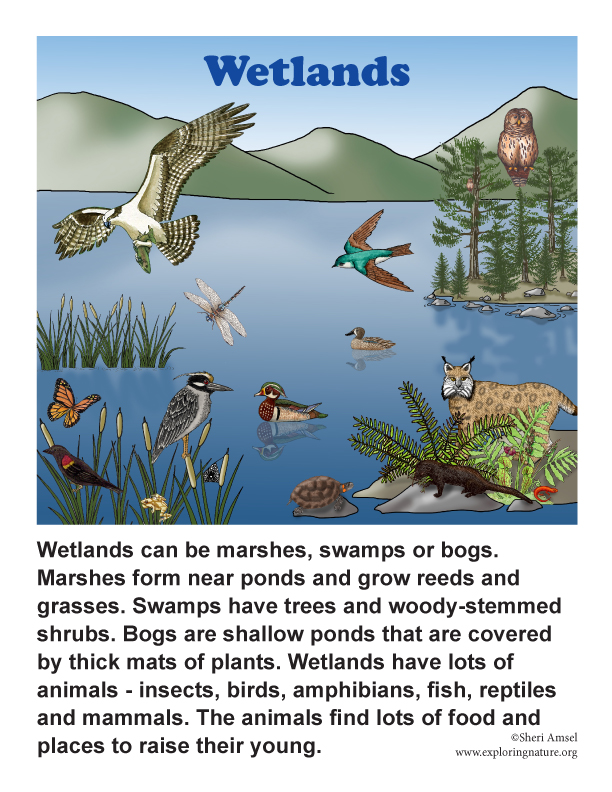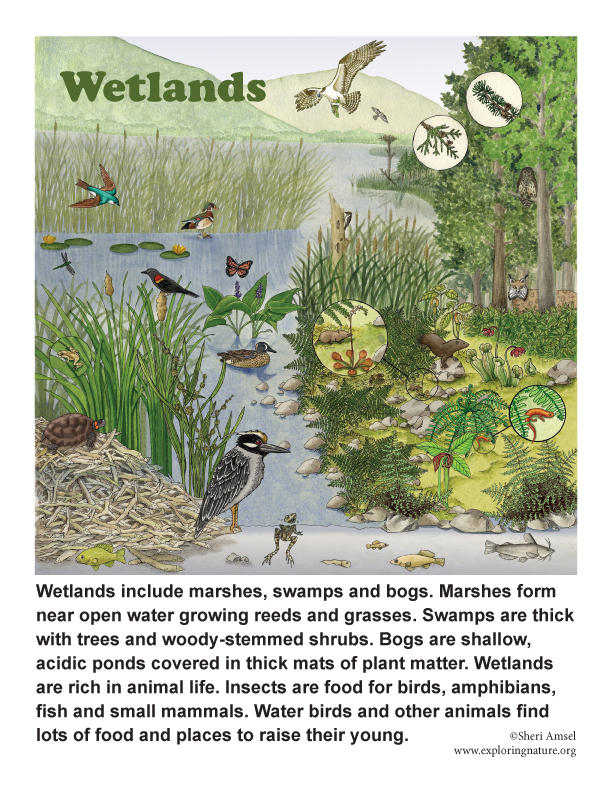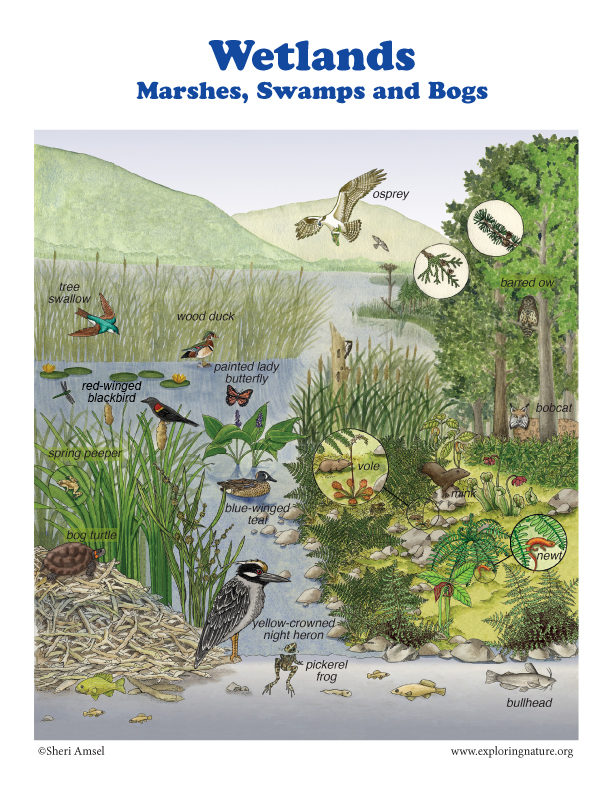

Marshes, Swamps and Bogs are found all over the world in wetter places (not in desert areas, of course).
There are many kinds of wetlands. Marshes form near ponds and lakes. Reeds, grasses and other soft-stemmed plants grow there. Swamps have more trees and woody-stemmed shrubs. Sometimes the growth is so thick that it's hard to walk through a swamp. Bogs begin as shallow ponds that slowly fill with rotting leaves and plants. Then mosses and other plants grow spreading out from the shore across the surface of the bog, forming a thick mat. Under the mat there is little air and the acids from plants build up. This slows decay, so that things, which fall into bogs, take a long time to rot.
Lots of animals live in swamps, bogs and marshes. Insects are food for the birds, amphibians, fish and small mammals. Water birds and other animals find lots of food and places to raise their young. Male red-winged blackbirds are very territorial. They watch over the females nesting in the cattails that they have claimed, calling loudly. They will attack anyone that tries to enter their territory, even humans. Shrews often make their homes in wetlands. A shrew is so small and its heart beats so fast that to keep warm and healthy it has to eat a lot of food. They are too small to hibernate in the winter because they need to eat all the time to stay alive. They are fierce hunters and will attack mice that are much bigger than they are. Some shrews, like the short-tailed shrew, even has a poison in their saliva that will stun whoever they bite so they can eat them. One short-tailed shrew has enough toxin to kill 200 mice! One of the first frogs to begin calling in wetlands in the spring is the song the tiny spring peeper. It has a whistle and trill that rattles through the cool, spring air. In early evening when the males start to call, all of them together make a big sound. If you get close to where they are gathered, in bushes and trees over the water, their loud chorus can actually tickle your skin. Dragonflies have been on earth since the days of the dinosaurs. They were much larger back then than they are now, but they are master flyers, catching prey in mid-flight. People once thought that the dragonfly was a pest, but now we know when a dragonfly is buzzing around your head it is after the mosquito that was just about to bite you.
The soil is so wet that it is not easy for plants to grow in. Not all trees can grow there. Some plants, like cattails and pickerelweed, grow right in the water. Even though plants can make their own food using sunlight, they also need good soil with minerals to grow well. Soils in wetlands have their minerals washed away, so some plants have found other ways to get the food they need. They eat insects. Insectivorous plants trap insects and dissolve them for their minerals. Sundews have tiny drops of sweet sticky goo on the hairs on their leaves. Insects land thinking that the fluid is nectar. But it's really glue. As the fly struggles it triggers the sundew leaf to begin to curl up trapping the fly inside. Then the sundew digests the bug. Pitcher plants have special leaves shaped like hollow tubes, open on top. A sweet smell attracts insects inside to look for nectar. Bright colored lines run down into the tube leaf. The insect follows it down like a road map to search for the sweet nectar. But there is no nectar. Instead they find a pool of acidic water. They try to climb back out, but stiff hairs point down and block their escape. They are trapped. Soon they tire and fall into the acidic pool where they are digested by the plant. The jack-in-the-pulpit is a weird-looking plant found in wet woods and swamps. It has a club-shaped flower that turns into bright red berries late in the summer. It looks a bit like the pitcher plant with its striped, cup-like leaves, but the jack-in-the-pulpit is not a flytrap.
Related Activity:
Bog Coloring Page
Bog Hidden Picture
Marsh and Swamp Coloring Page
Wetland Coloring PageWetland Close Up - Hidden Picture
Wetlands Hidden Picture
Wetland Mural Making Activity
More Wetland Mural Resources
Related Visual Aid:
Bog (Underwater) Poster
Bog Life - Carnivorous Plants Poster Poster
Download Hi-Res B&W Wetland Diagram
Download Hi-Res Wetland Poster
Download Hi-Res Wetland Color Diagram
Lakeside Poster
Wetland Poster
Related Testing and Assessment:
Bog Labeling Page
Marsh Animals Labeling Page
Wetland - Read and React Quiz
When you research information you must cite the reference. Citing for websites is different from citing from books, magazines and periodicals. The style of citing shown here is from the MLA Style Citations (Modern Language Association).
When citing a WEBSITE the general format is as follows.
Author Last Name, First Name(s). "Title: Subtitle of Part of Web Page, if appropriate." Title: Subtitle: Section of Page if appropriate. Sponsoring/Publishing Agency, If Given. Additional significant descriptive information. Date of Electronic Publication or other Date, such as Last Updated. Day Month Year of access < URL >.
Amsel, Sheri. "Marshes, Swamps and Bogs" Exploring Nature Educational Resource ©2005-2024. December 13, 2024
< http://www.exploringnature.org/db/view/1748 >
